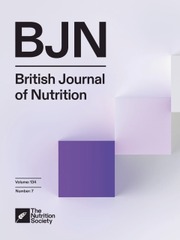Crossref Citations
This article has been cited by the following publications. This list is generated based on data provided by
Crossref.
Duffield-Lillico, A. J.
Shureiqi, I.
and
Lippman, S. M.
2004.
Can Selenium Prevent Colorectal Cancer? A Signpost From Epidemiology.
JNCI Journal of the National Cancer Institute,
Vol. 96,
Issue. 22,
p.
1645.
Johnson, I. T.
2004.
Micronutrients and cancer.
Proceedings of the Nutrition Society,
Vol. 63,
Issue. 4,
p.
587.
Rayman, Margaret P.
2004.
The use of high-selenium yeast to raise selenium status: how does it measure up?.
British Journal of Nutrition,
Vol. 92,
Issue. 4,
p.
557.
Shankar, Sharmila
and
Srivastava, Rakesh K
2004.
Enhancement of therapeutic potential of TRAIL by cancer chemotherapy and irradiation: mechanisms and clinical implications.
Drug Resistance Updates,
Vol. 7,
Issue. 2,
p.
139.
Fernández-Bolaños, José G.
López, Óscar
Ulgar, Vı́ctor
Maya, Inés
and
Fuentes, José
2004.
Synthesis of O -unprotected glycosyl selenoureas. A new access to bicyclic sugar isoureas.
Tetrahedron Letters,
Vol. 45,
Issue. 21,
p.
4081.
Lipinski, B.
2004.
Re: Science Peels the Onion of Selenium Effects on Prostate Carcinogenesis.
JNCI Journal of the National Cancer Institute,
Vol. 96,
Issue. 21,
p.
1640.
Gorinstein, Shela
Drzewiecki, Jerzy
Leontowicz, Hanna
Leontowicz, Maria
Najman, Katarzyna
Jastrzebski, Zenon
Zachwieja, Zofia
Barton, Henryk
Shtabsky, Boris
Katrich, Elena
and
Trakhtenberg, Simon
2005.
Comparison of the Bioactive Compounds and Antioxidant Potentials of Fresh and Cooked Polish, Ukrainian, and Israeli Garlic.
Journal of Agricultural and Food Chemistry,
Vol. 53,
Issue. 7,
p.
2726.
Wong, Angela
and
Fitzgerald, Rebecca C.
2005.
Epidemiologic risk factors for Barrett’s esophagus and associated adenocarcinoma.
Clinical Gastroenterology and Hepatology,
Vol. 3,
Issue. 1,
p.
1.
Novoselov, Sergey V
Calvisi, Diego F
Labunskyy, Vyacheslav M
Factor, Valentina M
Carlson, Bradley A
Fomenko, Dmitri E
Moustafa, Mohamed E
Hatfield, Dolph L
and
Gladyshev, Vadim N
2005.
Selenoprotein deficiency and high levels of selenium compounds can effectively inhibit hepatocarcinogenesis in transgenic mice.
Oncogene,
Vol. 24,
Issue. 54,
p.
8003.
Huether, Alexander
Höpfner, Michael
Sutter, Andreas P.
Schuppan, Detlef
and
Scherübl, Hans
2005.
Erlotinib induces cell cycle arrest and apoptosis in hepatocellular cancer cells and enhances chemosensitivity towards cytostatics.
Journal of Hepatology,
Vol. 43,
Issue. 4,
p.
661.
Lyi, Sangbom M.
Heller, Laurence I.
Rutzke, Michael
Welch, Ross M.
Kochian, Leon V.
and
Li, Li
2005.
Molecular and Biochemical Characterization of the Selenocysteine Se-Methyltransferase Gene and Se-Methylselenocysteine Synthesis in Broccoli.
Plant Physiology,
Vol. 138,
Issue. 1,
p.
409.
Lü, Junxuan
and
Jiang, Cheng
2005.
Selenium and Cancer Chemoprevention: Hypotheses Integrating the Actions of Selenoproteins and Selenium Metabolites in Epithelial and Non-Epithelial Target Cells.
Antioxidants & Redox Signaling,
Vol. 7,
Issue. 11-12,
p.
1715.
Limburg, Paul J.
Wei, Wenqiang
Ahnen, Dennis J.
Qiao, Youlin
Hawk, Ernest T.
Wang, Guoqing
Giffen, Carol A.
Wang, Guiqi
Roth, Mark J.
Lu, Ning
Korn, Edward L.
Ma, Yurong
Caldwell, Kathleen L.
Dong, Zheiwei
Taylor, Philip R.
and
Dawsey, Sanford M.
2005.
Randomized, Placebo-Controlled, Esophageal Squamous Cell Cancer Chemoprevention Trial of Selenomethionine and Celecoxib.
Gastroenterology,
Vol. 129,
Issue. 3,
p.
863.
Whanger, P
2005.
Nutrition and Cancer Prevention.
Vol. 20052271,
Issue. ,
Gad, Shayne C.
2005.
Encyclopedia of Toxicology.
p.
774.
Gerald F., Combs
2005.
Current Evidence and Research Needs to Support a Health Claim for Selenium and Cancer Prevention.
The Journal of Nutrition,
Vol. 135,
Issue. 2,
p.
343.
Knapp, Spencer
and
Darout, Etzer
2005.
New Reactions of Selenocarboxylates.
Organic Letters,
Vol. 7,
Issue. 2,
p.
203.
Madeja, Zbigniew
Sroka, Jolanta
Nyström, Christina
Björkhem-Bergman, Linda
Nordman, Tomas
Damdimopoulos, Anastasios
Nalvarte, Ivan
Eriksson, Lennart C.
Spyrou, Giannis
Olsson, Jerker M.
and
Björnstedt, Mikael
2005.
The role of thioredoxin reductase activity in selenium-induced cytotoxicity.
Biochemical Pharmacology,
Vol. 69,
Issue. 12,
p.
1765.
Muñiz-Naveiro, Óscar
Domínguez-González, Raquel
Bermejo-Barrera, Adela
Cocho de Juan, José A.
Fraga Bermúdez, José M.
Goris Pereiras, Alfonso
López Santamariña, Antonio
Martínez Lede, Ismael
Valledor Puente, Javier
Fernández-Couto Gómez, Luis
and
Bermejo-Barrera, Pilar
2005.
Selenium Content and Distribution in Cow's Milk Supplemented with Two Dietary Selenium Sources.
Journal of Agricultural and Food Chemistry,
Vol. 53,
Issue. 25,
p.
9817.
Rayman, Margaret P.
2005.
Selenium in cancer prevention: a review of the evidence and mechanism of action.
Proceedings of the Nutrition Society,
Vol. 64,
Issue. 4,
p.
527.

